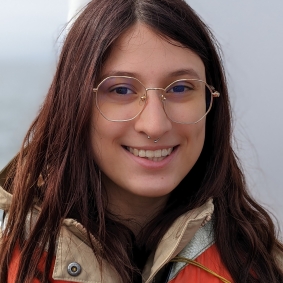Eight students will be presenting the summer work at the Ocean Sciences Meeting in March 2022!
Dana Sanchez, Pennsylvania State University
Class Year:
2022Mentor:
Judy O'Neil, Ph.D.Project Title:
Sediment Provides Nutrients for Benthic Cyanobacteria in a Submersed Aquatic Vegetation Bed Within The Chesapeake Bay - Implications for Nitrogen FixationAbstract:
In the early 2000s, at the mouth of the Susquehanna River in the freshwater regions of the Chesapeake Bay, a submersed aquatic vegetation (SAV) bed experienced a rapid resurgence, after complete disappearance due to sediment loading from Hurricane Agnes in 1972. Since then, a filamentous nitrogen-fixing cyanobacterium called Lyngbya carpets the bottom in the spring and floats to the surface in dense mats during the summer. As benthic nitrogen-fixing cyanobacteria, Lyngbya produces nitrogen compounds that may alter the nutrient dynamics in the submersed aquatic vegetation bed. This study aims to investigate environmental factors influencing nitrogen fixation rates by Lyngbya wollei and benthic sediment nitrogen fixation from the Susquehanna Flats with different seasonal proximities to the sediment in June and July along a N-S and E-W transect moving away from the mouth of the river. Bioassays with nutrient addition triplicate treatments of 10μm NO3, 5 μm PO4,,10μM NH4 and 10μM NO3 in combination with 5 μm PO4 (N + P) were done. A suite of water quality parameters were measured at all study sites, and sediment and Lyngbya experiments took place under various conditions. Nitrogen fixation was measured using the acetylene reduction assay on a Shimadzu gas chromatograph. The June bioassay showed there was a strong positive response to the PO4 treatment while NO3 suppressed nitrogen fixation. We then found there were higher nitrogen fixation rates with Lyngbya growing on sediment than without and even higher rates with the addition of clay and sediment. In addition to this, Lyngbya biomass appears to increase with distance from the mouth of the Susquehanna River. Our findings lead us to hypothesize that earlier in the season the Lyngbya likely uptakes inorganic N (NO3 and NH4) from the sediment, so it doesn’t have to perform the energetically demanding process of nitrogen fixation. Once nitrogen is depleted it has a competitive advantage over non-diazotrophic organisms, by switching to nitrogen fixation. Phosphorus can then become the limiting nutrient which it can also access from the sediment for nitrogen fixation. After being removed from contact with the sediment the Lyngbya appears to acclimate to lower nutrient conditions in the water and switches to fixing non-limiting atmospheric nitrogen dissolved in the water. This study has implications for Chesapeake Bay nitrogen budgets and modeling the nutrient dynamics in this valuable SAV bed.
Location:
Horn Point LaboratoryPresentations:
Sanchez, D.*, S. Keller, J. O'Neil, and M. Owens. 2023. Sediment provides limiting nutrients for benthic cyanobacteria nitrogen fixation in a recovering submersed aquatic vegetation. Coastal Estuarine Research Federation Biennial Meeting, Portland, OR.




